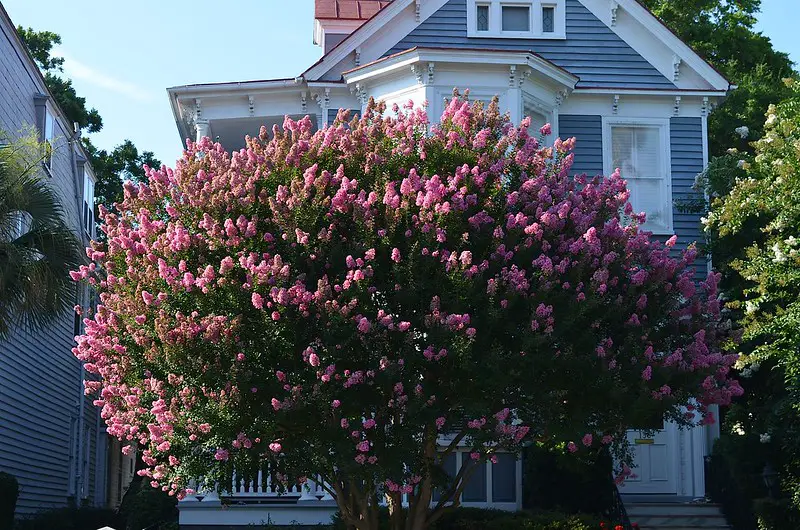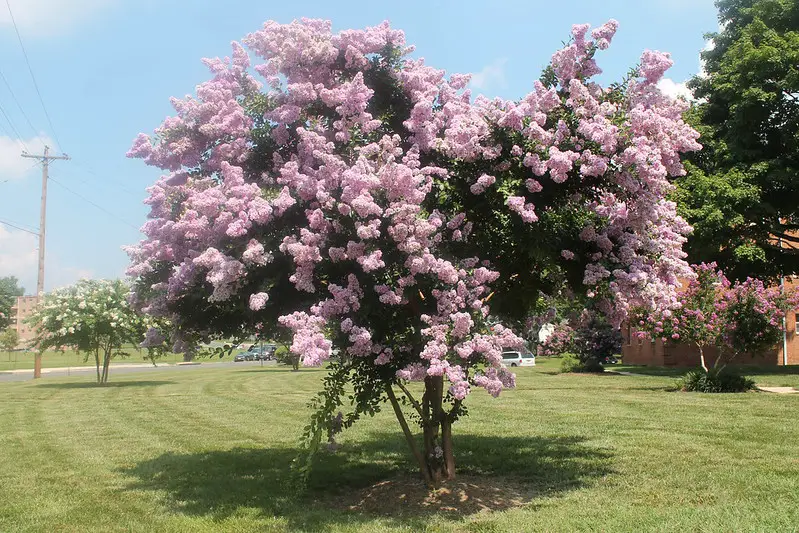Known as the ‘Lilac of the south’, crape myrtle is grown for its flowers that have a very long bloom in the summer. Crape myrtle can be grown as a tree or a shrub, while the flowers come in a wide range of colors. If you’d like to give crape myrtle a go, take a look at this useful care guide.

What is a Crape Myrtle?
Crape myrtle (or crape myrtle) are summer-flowering trees and shrubs of the Lagerstroemia genus. The genus consists of around 50 species and hundreds of selected cultivars of deciduous trees and shrubs that are cultivated in warm climates.
Crape myrtles are mainly grown for their long-lasting flowers with the color varying from white, lilac, pink, purple, red and many other shades. But besides their showy flowers that last throughout the entire summer (in some varieties until the first frost), crape myrtles offer a year-round interest – the foliage provides the interest during the fall, while the shedding bark has an attractive appearance during the winter.
Crape myrtles are commonly used in landscaping with various designing possibilities. They can be grown as single-stem trunks, or multi-trunk trees. You can also choose tall varieties that grow over 30, or you can go for dwarf or semi-dwarf varieties. They are also suitable for growing in containers.
One of the best things about crape myrtles is that they are fast-growers. They can grow up to 3 feet per year.
Where, When and How to Plant Crape Myrtle
Crape myrtles are native to tropical and subtropical regions and are extremely heat-tolerant. They love sunny positions with at least six hours of sun per day, so choose a planting spot that will give them a plenty of sun. Not only your crepe myrtle will thrive well in these conditions, but will also have more blooms.
Crape myrtle will thrive in almost any type of soil – sandy, clay or loamy. However, they prefer slightly acidic soil (pH 5.5 to 7.5). If the soil is too alkaline, the foliage may turn yellow.
Plant crape myrtle in the fall or early spring. Put the plant in the hole deep as the nursery container, but twice as wide. Water the plant thoroughly. The plant should establish the root system before the frost arrives (if planted in fall) or summer heats hits (if planted in spring).
How to Care for Crape Myrtle
Once the plant is established, taking care of crape myrtle is quite easy:
- Watering: Crape myrtles are extremely drought-tolerant so they don’t have any special water requirements once they are established. However, young plants should be watered once per week or even twice if the conditions are very hot and dry.
- Soil and Fertilization: Since crape myrtles love slightly acidic soil, be sure to keep the soil level between 5.5 to 7.5 pH. You can test your soil using a soil test kit. Also, Apply a high-nitrogen fertilizer in the spring.
How to Prune Crape Myrtle
Before planting a crape myrtle, be sure what are your needs. Do you want a single-stem trunk or multi-stem crape myrtle? Do you want a small tree or a taller one? Do you want a crape myrtle bush?
It’s highly important to purchase an adequate variety to avoid stressing and murdering a plant. If you’d like a smaller tree, don’t purchase a tall variety. The same goes for trunk. If you’d like a single-stem trunk, purchase a single-stem plant to start with.
Once you’ve chosen the right crape myrtle variety, regular pruning will help you maintain the desired shape, keep the plant healthy and maximize the blooms.
Since crape myrtles carry their blooms on new growth, you should remove old stems in the late winter or the early spring while the plant is still dormant.
Avoid chopping the top of the plant (so-called ‘crape myrtle murder’). Instead, just thin your crape myrtle.
First, remove suckers, low-growing stems, and any dead or week branches. Cut back the unnecessary stems and leave just a few main trunks. Next, thin the crown. Remove tangled branches and make space for each branch to grow. Cut just above the bud facing the direction you want the branches to grow.
Remove any excess stems and branches in the middle of the plant to allow better circulation and avoid pest infestation.
If you’d like a single-stem tree, start pruning while the plant is still young. Choose a single dominant stem and regularly prune away other stems at the base.

Crape Myrtle Varieties
The two most popular crape myrtle species are the common crape myrtle (L. indica), giant crape myrtle (L. speciose), and Japanese crape myrtle (L. faueri). However, there are many selection and hybrids that come in a wide range of flower colors, sizes, and hardiness.
L. indica – Also known as the common crape myrtle, this species is the most popular among crape myrtles. It is hardy in the US zones 7 to 9.
L. indica × L. faueri hybrids – These hybrids are completely resistant to powdery mildew and are more hardy than the common crape myrtle, so you can grow them in the zone 6 as well. Some of the popular hybrids are: ‘Tuskarora’, ‘Siren Red’, ‘Dynamite’.
If you’d like to choose crape myrtle based on its size, there are many varieties that offer different sizes, and the different colors of blooms and foliage:
- Very Tall Varieties (over 30 ft height): Fantasy (white flowers), Natchez (white), Muskogee (lavender)
- Tall Trees (20-30 ft tall): Biloxi (pale pink), Miami (dark pink), Wichita (magenta), Tuscarora (dark coral pink)
- Medium Trees (15-20 ft tall): Seminole (pale pink), Tuskegee (dark rose), Catawba (dark purple), Townhouse (white), Apalachee (lavender), Conestoga (lavender bicolor), Potomac (pink)
- Small Trees (10-15 ft): Acoma (white), Comanche (dark coral pink), Lipan (light lavender), Sioux (Dark Pink), Yuma (lavender bicolor), Osage (pink)
- Semi-dwarf varieties (5-10 ft): Caddo (pink), Hopi (light pink), Pecos (medium pink), Zuni (lavender), Cherokee (bright red), Tonto (dark fuchsia)
- Dwarf varieties (3-5 ft): Chickasaw (pink), Centennial (purple), Victor (dark red), Firecracker (light red)